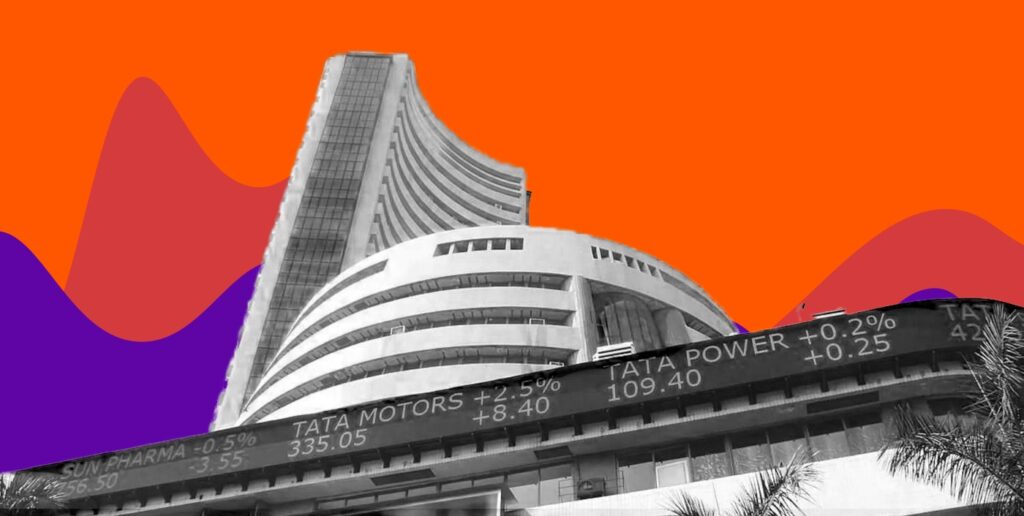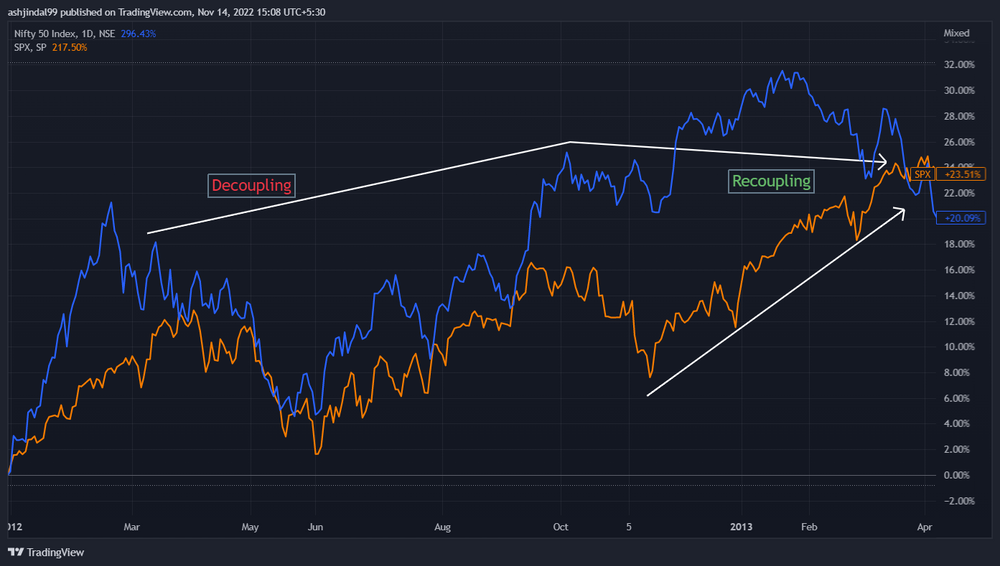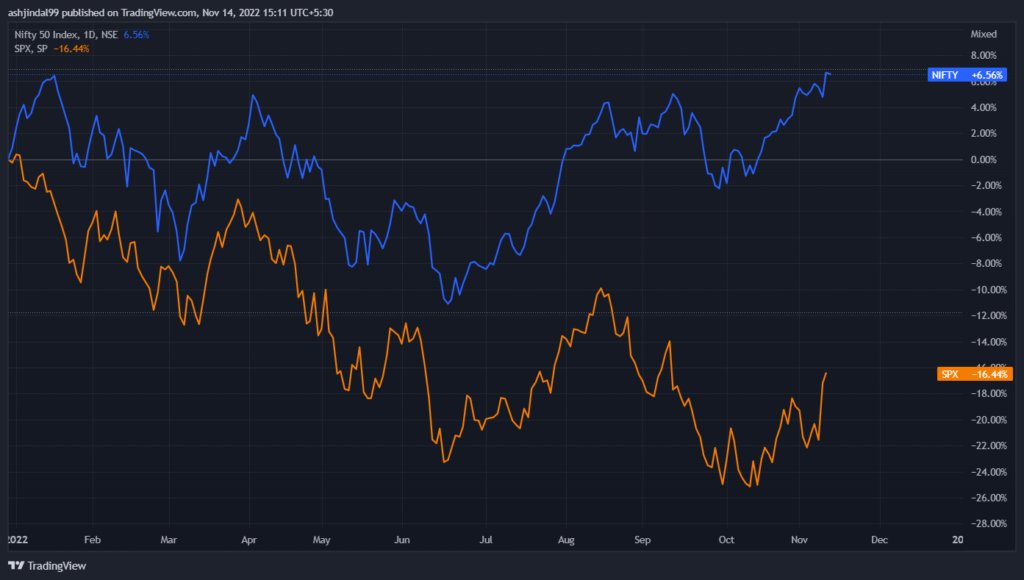
Correlation between India markets and the global ones has remained over 0.9 for 10 and 25-year periods.
- Nifty has outperformed all major global indices in the past year
- The markets have decoupled from each other historically, but only for a brief period
- Indian markets have stayed resilient when other markets have fallen quickly
Nifty 50 has been flat in the past year, while S&P 500 has lost ~20% in the same period. At the same time, Germany is down ~15%, Shanghai ~14% and Japan is over 6% down. Is the Indian outperformance sustainable? History suggests it might not be.
The US has been suffering from inflation and karma due to excessive quantitative easing during the COVID-19 led slowdown. Europe has been stuck in an energy crisis-led inflation spiral with no fault of its own.
Not just that, the central banks have been on a rate hike spree to drain demand in what is a supply shock-led inflation. It hasn’t done much to lower inflation, but the equities have indeed faced its brunt. The cost of capital has grown, which means that equities have become less attractive, and people rush to bonds to invest.
Throw in China, an important link struggling with problems of its own, and this springs up a disaster. And a chain is as strong as its weakest link. One thing goes down, and everything falls apart one by one. Take the example of the 2007-08 subprime crisis. The fall of the US economy meant everything went down along. India escaped with a few bruises, and history seems to be repeating. India has managed to stay afloat in dire situations like these.
But have Indian markets decoupled from the global markets?
Are emerging markets insulated?
The first half of 2007 was about decoupling and how emerging markets would grow faster than the developed economies in the west. And the market moguls were proved right initially, as even though the US underwent a slowdown and S&P 500 was flat, Nifty grew by 58%.

But the chatter was short lived as it was back to square one. Nifty fell ~60% from the highs it made in mid 2007s. This died down only to come back in 2012. Nifty again outperformed S&P 500 in the first half, only to catch up with S&P 500 by 2013 when Taper Tantrum happened. A sharp correction in the global markets ensued.

Fast forward to COVID-19 led disruption, people started talking about how the global markets were highly correlated as the US markets and Indian markets moved in tandem, like twin sisters. Come 2022; we have again started talking about the two of the biggest markets decoupling from each other.
But will India be impacted if the US goes further down?
Given that India contributes 14.5% of the MSCI Emerging Market Index, and FIIs might withdraw from the index owing to currency, inflation and interest rate risks and invest in a safe haven like US Dollar, Indian markets can be badly hurt even when the fundamentals look strong.
Not just that, but given that we consume commodities on a large scale, events like the Russia-Ukraine war (both countries are huge commodity suppliers) can hurt our fundamentals badly. Given that our IT companies are heavily reliant on the US and the metal companies depend on global commodity prices, India is walking a tightrope currently.
Hence, given that the economies are so interrelated, it is hard for the emerging markets to be insulated, India more so.
Is it just Indian markets’ resilience?
More than decoupling, this looks like a case of resilience. The steep fall in the US markets seems to have no impact on India. There has been enough liquidity, sound policy-making and quick structural moves. India was quick to raise interest rates when it saw inflation coming, even quicker than the US for the first time in a while. We have always been the followers, but being the leader, in this case, has helped us multifold.
With a stable political scenario, fast growth and domestic and retail investors holding the ship together, India has grown leaps and bounds in the past two years and a half. This has meant that only the Indian markets have grown by over 100%. No other market has been even close. We are becoming less reliant on foreign inflows, and even if the MSCI Emerging Markets Index sees an outflow, we might not be impacted as much. But we need to see every fall as a buying opportunity.
We are on a more level playing field as compared to pre-COVID. And if we continue to remain on the same track, more inflows will come to the Indian markets over the coming few years. And with a new credit cycle on the horizon, domestic demand is set to grow in tandem with the markets and economy.
The correlation US and Indian markets
The economies have faced structural changes, but the correlation remains strong as ever. Nifty is highly correlated to the US markets, with a correlation of 0.96 over the past 25 years and 0.97 in the last 10 against Dow Jones. Similarly, for Nasdaq and S&P 500, the correlation has been around 0.95 for 25 and 10-year periods.
Even against other indices like DAX, and FTSE, the correlation has stayed above 0.9, which means that the domestic markets can perform well only when the global sentiment is good. If major markets go down, so does India. During the dot com crisis of 1997-2002, the correlation was 0.69. The 2007-12 time period also matched the number.
Hence even though our markets have outperformed the US and other global markets, we must remain cautious. This is a global village we live in, and global investors might start pulling out money from Indian markets if the situation turns dire.
India: A domestic economy
As much as the world is becoming a global economy, India is still a domestic demand-oriented economy. And it is happy signs that the demand is still strong domestically and the capital expenditure (CapEx) cycle, driven by the PLI scheme, is doing well too. China+1 strategy is helping the demand and exports.
With FDI coming in along with the domestic CapEx cycle, the economy has started to rise steeply. And in a scenario like this, the markets are expected to outperform. Decouple, not so much. Not to forget the growing Indian middle class and with it becoming a part of the stock market growth story, the returns are expected to accelerate.
Domestic consumption drives the Indian economy, and if consumption can be revived, we are looking at burgeoning growth for India. That said, no sector can be left untouched since India comes with a vast potential to disrupt almost all sectors and become the leader in many of them.
We have been starved of growth, but now it is impossible to ignore us.
You can love me or hate me, but you can’t ignore me
Indian markets to FIIs
If reports from Morgan Stanley are anything to go by, India will surpass Germany and Japan to become the third-largest economy by 2027. This growth can be attributed to three megatrends, i.e. digitalization (which India has climbed onto well), global offshoring (steady growth here), and energy transition (focus shifting to this as well). This will make us more reliant on the outside world and not just on domestic consumption.
Our central bank has been very proactive in policy-making and maintaining the currency rates. It has also started encompassing the stock market now, much like how it does in the US. And the State’s intervention is the need of the hour, with the focus shifting on fiscal policies through state expenditure, leading to an increase in aggregate demand and, thus, employment.
And with our people not ageing anytime soon, we are on our way to growth and towards being correlated to the global markets even more.
However, there is not much to worry about for long-term investors since India is touted to be the fastest growing market anyway. With the economy expected to grow at 8-9% and inflation at around 5%, the index can grow at ~15%. This makes us the most attractive market. The golden period is on the horizon.
